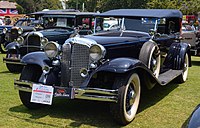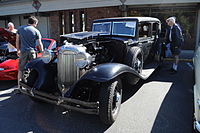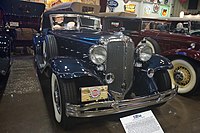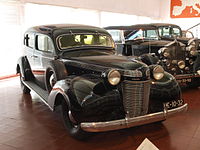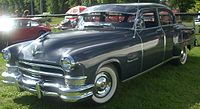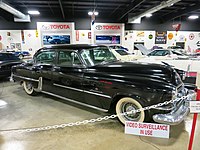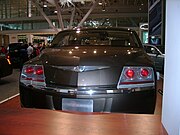Chrysler Imperial
| Chrysler Imperial | |
|---|---|
FF layout (1989–1993) |
The Chrysler Imperial, introduced in 1926, was
For several decades and multiple generations, the Imperial was the exclusive Chrysler and the favorite choice of luxurious transportation for senior executive leadership, government officials, royalty and various celebrities in comparison to the more affordable Chrysler New Yorker. Over the years the appearance, technological advancements and luxurious accommodations updated with the latest trends and fashionable appearances. Limousines, town cars and convertibles were the usual appearances, while special coachwork choices were provided by the industry's best providers, to include Derham, Fleetwood, LeBaron, and others.
The Chrysler Imperial rose was cultivated in 1952 and used to promote the brand.[3]
1926–1930
| Series E-80 (1926)/Series 80 (1927)/Series 80L (1928-1930) | |
|---|---|
| Layout | FR layout |
| Related | Chrysler Six |
| Powertrain | |
| Engine | 288.6 cu in (4.7 L) Chrysler I6 309.3 cu in (5.1 L) Chrysler I6[4][5][6] |
| Transmission | 3-speed manual 4-speed manual |
| Dimensions | |
| Wheelbase | 120 in (3,048 mm) 127 in (3,226 mm) 133 in (3,378 mm) 136 in (3,454 mm) |
| Length | 183.5 in (4,661 mm) (1926–1927)[4]) |
In 1926,
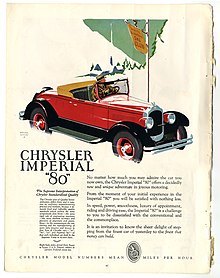
The car set a transcontinental speed record in the year it was introduced, driving more than 6,500 miles (10,460 km) in the week. The car was chosen as the
Imperials could be distinguished from Chrysler products by the use of a distinctive scalloped hood and radiator shell and a 120 in (3,048 mm) wheelbase, which shared an appearance with Packard and the Buick Master Six. The Berline Limousine was listed at US$3,595 ($61,872 in 2023 dollars [11]).[5]
The 1927 Imperial Series 80 saw minor engineering improvements, while the high compression "Red Head" 288.6 cu in (4.7 L) straight-six was the only engine available on a choice of 120 in (3,048 mm), 127 in (3,226 mm) or special order 133 in (3,378 mm) wheelbases. Five two-door coachwork choices included roadsters and convertible, while there were nine sedan, town car, phaeton and limousine choices. The top level Town Car was listed at US$5,495 ($96,384 in 2023 dollars [11]).[5] Standard equipment on roadster and phaeton open-body coachwork selections included wind wings and leather exterior door trim panels, while many cars were painted in contrasting two-tone paint. The convertible was equipped with functioning landau irons.[5] In 1927, an Imperial was driven at a high speed along the Lincoln Highway from San Francisco to New York to Los Angeles, covering a total distance of 6,726 mi (10,824.4 km) non-stop, with an average speed of 40 mph (64 km/h).[5]
1928 offered a 136 in (3,454 mm) wheelbase with the designation Series 80L. Coachwork choices expanded with five provided by Briggs, and six choices from LeBaron, one Derham Convertible Sedan, one Phaeton from Locke, and four Dietrich convertible coupes and sedans, listing the Dietrich Convertible Sedan at US$6,795 ($120,572 in 2023 dollars [11]). Total Chrysler calendar year production was recorded at 160,670, their all-time high pre-war until decades later[5]
Model years 1929 and 1930 Series 80L were essentially unchanged from the 1928 version as engineering efforts were focusing on the 1931 Series CG Straight Eight, while there were some engineering advancements, to include thermostatically controlled automatic adjusting exterior radiator shutters, vertical hood louvers and a four-speed manual transmission. Coachbuilder Locke provided four convertible choices in both coupe and sedan configurations, and hydraulic four wheel brakes were now standard on all Chrysler products. The top level 1930 Series 80L Limousine was listed at US$3,575 ($65,205 in 2023 dollars [11]).[5]
-
1926 Chrysler Imperial Series E80 Sedan by Briggs
-
1927 Chrysler Imperial Series 80 Sedan by Briggs
-
1927 Chrysler Imperial Series E-80 roadster
-
1928 Chrysler Imperial Series 80L Phaeton by Dietrich
-
1929 Chrysler Imperial Series 80L Custom Roadster by Locke
1931–1933
| Series CG/CH&CL/CQ&CL | |
|---|---|
| Layout | FR layout |
| Related | Chrysler Royal DeSoto Eight Series CF (1930) Dodge Eight (1930) |
| Powertrain | |
| Engine | 298.65 cu in (4.9 L) Chrysler I8 (Series CQ) 384.4 cu in (6.3 L) Chrysler I8[12][13] |
| Transmission | Multi-range 4-speed manual[5][12] |
| Dimensions | |
| Wheelbase | 125 in (3,175 mm) (1933 Series CQ) 135 in (3,429 mm) (1932 Series CH) 145 in (3,683 mm) (Series CG & CL)[5][12] |
| Length | Imperial Custom 212.5 in (5,398 mm) (1932)[12] |
The all-new 1931 "Chrysler Imperial 8" introduced the new in-line 8-cylinder engine which was shared with the
The Imperial Series CG offered four sedan coachwork choices from

Model year 1932 introduced the junior Series CH Imperial while the previous Series CG became the Series CL and took the name Imperial Custom to continue to provide individually requested, customized vehicles.[5] The Series CH was related to the Chrysler Series CP in that the straight-eight engine, and most features were shared while the Imperial Series CH was offered with many standard features that were optional on the Series CP. The Series CH and CL featured all steel body work, a double drop "girder truss" chassis frame, split windshields, dual sun visors, and trumpet horns. The ignition was provided by Delco-Remy, the brakes were hydraulic and the transmission was a four-speed manual transmission with an optional automatic vacuum operated clutch. The body styles offered on the Series CH were a two-door, two-passenger roadster convertible with available rumble seat, a four-door sedan or a four-door convertible. The roadster listed price was US$1,925 ($42,989 in 2023 dollars [11]) while the four-door convertible was US$2,195 ($49,018 in 2023 dollars [11]) which made the more esteemed "Imperial" brand almost identically priced to "Chrysler" branded products, while the engine displacement on the Series CH was larger.[5] The 1932 Series CL remained the more prestigious Imperial and all coachwork was provided by LeBaron offering four convertible body styles along with a conventional seven-passenger sedan or eight-passenger limousine, while documented records show one two-passenger Roadster and one Landau Limousine were manufactured.[5] Records show that 32 Series CL Sedan Limousine by LeBaron were sold for US$3,295 ($73,583 in 2023 dollars [11]).
The Series CQ Imperial was all-new for 1933 from the previous Series CH and the wheelbase lost 10 in (254 mm) and the 298.65 cu in (4.9 L) Chrysler I8 had reduced displacement. Three two-door, two-passenger coupes to include a Victoria and Roadster Convertible, and two four-door, five-passenger choices with one sedan convertible were offered by Briggs. Mechanical improvements offered were a silent, helical gear three-speed transmission, an improved oil filter and an automatic choke for the Stromberg IV Model EX-32 carburetor. Only three sedan coachwork choices were offered for the Series CL sedan with the 146 in (3,708 mm) wheelbase.[5] Production records document 3,838 Series CQ and 151 Series CL were manufactured, including six Chassis and Cowl only requests.[5]
-
1931 Chrysler Imperial Series CG Phaeton
-
1931 Chrysler Imperial Series CG Dual Cowl Phaeton by LeBaron
-
1931 Chrysler Imperial Series CG by Briggs
-
1931 Chrysler Imperial Series CG Convertible Victoria by Waterhouse
-
1932 Chrysler Imperial Series CH Sedan by Briggs
-
1932 Chrysler CL Imperial
-
1932 Chrysler Imperial Custom Series CL Convertible Sedan by LeBaron
-
1933 Chrysler Imperial Series CQ Sedan by Briggs
-
1933 Chrysler Imperial Custom Series CL Dual Cowl Phaeton by LeBaron
1934–1936
| Series CV,CX,CW/C-2,C-3,CW/C-10,C-11,CW | |
|---|---|
Chrysler I8 (Series CW)[5] | |
| Transmission | 3-speed manual 4-speed manual w/overdrive[5] |
| Dimensions | |
| Wheelbase | Imperial CV 128 in (3,251 mm) (1934–1936) Imperial CX 137.5 in (3,492 mm) (1934) Imperial CW 146.5 in (3,721 mm) (1935–1936)[5][17] |
The Chrysler Imperial introduced in 1934 offered the '
The 1934 Imperial Airflow Series CV offered the 323.5 cu in (5.3 L)
The public was put off by the unconventional styling and the "Airstream" appearance on Chryslers outsold the "Airflow" by 3 to 1. The 1935 Imperial Airflow Series C-2 and Series C-3 were carryover from resources not used for 1934 due to underwhelming sales after the appearance was panned in favor of competitors, while the conventionally styled Chrysler Airstream was better received that replaced the Chrysler Series CA and Series CB. Total production documented records show 2,598 Series C-2 coupes and sedans were manufactured, while just 125 Series C-3 rolled off the assembly line, accounting for both coupe and sedan production. The top level Series CW recorded only 32 limousines that could accommodate eight passengers, offering four different coachwork choices for a minimum listed price of US$5,000 ($111,117 in 2023 dollars [11]).[5]
1936 was the last year for the "Airflow" appearance, while there were some enhancements and features added to entice buyers. A new grille, all-steel roof construction and a luggage compartment was added. The wheelbase was lengthened and the doors and side windows. The front windshield was either split or curved one piece on the Imperial Custom and continued to be extendable from the base outwards while a separate retractable cowl ventilator remained to provide fresh air inside the passenger compartment. Production numbers continued to fall to a total of 4,500 Series C-10 sedans and coupes and 75 Series C-11 sedans and limousines. A total of 10 Series CW were documented to be sold while the actual manufacture date were previous years that were registered, and dated as 1936 models. The pricing structure was simplified as US$1,475 ($32,779 in 2023 dollars [11]) for the Series C-10 for the coupe or sedan, and US$2,475 ($55,003 in 2023 dollars [11]) for the Series C-11 sedan or limousine. While 1936 was the most profitable season for Chrysler since 1929, the Airflow program was cancelled, and the Imperial Custom Airflows are recognized as Classics by the Classic Car Club of America.[5]
-
1934 Chrysler Imperial Series CX Airflow Limousine
-
1935 Chrysler Imperial Series C-2 Coupe
-
1936 Chrysler Imperial Custom Series C-11 Airflow Sedan
-
1936 Chrysler Imperial Series C-10 Airflow Sedan
-
1936 Chrysler Imperial Series C-10 Airflow Sedan
1937–1939
| Series C-14,C-15,CW/C-19,C-20/C-23,C-24 | ||
|---|---|---|
Curb weight 3,450–3,835 lb (1,565–1,740 kg)(1938)[5] | | |
Chrysler reverted to body on frame construction and there were three models in this generation designated as Imperial. The polarizing appearance was modified with an return to "torpedo" styling, sharing the appearance of a long, straight hood and cowl and moving the headlights outwards into the front fenders with the more successful "Airstream" appearance.[5] The Series C-14 offered the straight eight, shared with the Chrysler Royal C-16 . The Series C-15 was the Imperial Custom and the Town Sedan Limousine, with blind rear quarter panels and was available on request. The top level Imperial Custom Series CW continued to be offered but was very exclusive, using a 146.5 in (3,721 mm) wheelbase while eliminating the "Airflow" nameplate. Innovations for 1937 included built-in defroster vents, safety-type interior hardware (such as flexible door handles and recessed controls on the dash[19]), seat-back padding, and fully insulated engine mounts. Brakes were 13-inch drums, then in 1939 they expanded to 14 inches,[20] but shrunk to 12-inch drums in 1940.[21] Front suspension was independent.[20] Unusually for ventilation, it had a concealed crank to extend the base of the split windshield outward and the top edge of the engine hood was hinged at the cowl and opened from the grille and up.[5] Access to the engine was accommodated with side hood panels that were released by catches on the inside. An Imperial Custom Series C-15 Convertible Sedan by Derham was used as the AAA Official Car at the 1937 Indy 500 and was painted silver and black to celebrate the racetracks 25th anniversary.[5]
According to 1937 documented records, 11,976 Series C-14 Touring Sedans were produced at a listed price of US$1,100 ($23,314 in 2023 dollars
For 1938, The Series C-19 was shared with the Imperial and all-new New York Special which became the New Yorker in 1939. While the New York Special was offered as a Business Coupe, of which no records show one was ordered and built, and a four-door Touring Sedan, the Imperial Series C-19 was offered in six body choices and the chassis was available separately for additional coachwork selections. Three convertible choices, to include a two-door roadster with rumble seat and a four-door convertible were listed between US$1,123 ($24,308 in 2023 dollars [11]) and US$1,595 ($34,937 in 2023 dollars [11]). The Imperial Custom offered three factory coachwork choices and five custom choices provided by Derham to include two convertible and two Town Car Limousines. The Imperial Custom Series CW was no longer offered.[5] According to documented records, 8,554 Series C-19 Touring Sedans were produced at a listed price of US$1,198 ($25,931 in 2023 dollars [11]).[5]
For 1939, model names and series numbers were updated. The Series C-23 was shared with the Imperial, the
Following an assassination attempt in 1937, an armoured Chrysler Imperial was purchased as the official car for António de Oliveira Salazar, the Prime Minister of Portugal.[23]
-
1937 Chrysler Imperial Series C-14 Touring Sedan
-
1937 Chrysler Imperial Custom Series C-15 LeBaron Town Sedan Limousine originally ordered by Walter P. Chrysler
-
1937 Chrysler Imperial Series C-14 Touring Sedan
-
1939 Chrysler Imperial Custom Series C-24 Town Phaeton by Derham
-
1939 Chrysler Imperial Custom Convertible Town Car by Derham transporting the King and Queen of England
1940–1948
| Series C-27/C-33/C-37/C-40 | ||
|---|---|---|
| Overview | ||
| Production | 1940–1948 | |
| Assembly | Chrysler I8[24] | |
| Transmission | 3-speed manual transmission with Fluid Drive w/overdrive Vacamatic 3-speed semi-automatic[25] | |
| Dimensions | ||
| Wheelbase | 145.5 in (3,696 mm)[26] | |
| Length | 1940 225.25 in (5,721 mm)[21] 235 in (5,969 mm) Curb weight 3,900–4,560 lb (1,769–2,068 kg)(1941)[5] | |
In 1940 the Imperial Crown Series C-27 was the only vehicle to wear the "Imperial" nameplate and was offered in four body styles labeled as six-passenger Sedan, an eight-passenger Sedan, the eight-passenger Limousine, and the six-passenger Derham Parade Phaeton.[5][25] The styling was shared with all Chrysler models for that year and offered front fender parking lights with conventional running boards, and distinguishing a Chrysler model was limited to a nameplate attached on the front fender just below the engine hood, interior upholstery and standard features installed that were optional on other models. The six-passenger sedan offered storage compartments in the front seatbacks and foot rests, while the eight-passenger sedan replaced the storage compartments with accommodation for storing the retractable jump seats and no foot rests. The limousine offered a retractable glass partition between the driver and passenger compartment, installing leather seating for the driver and wool upholstery for the passenger compartment, Lockheed hydraulic brakes,[5][27] and two-speed electric windshield wipers were standard.[26] The listed price for the limousine was US$2,695 ($58,611 in 2023 dollars [11]).
The 1941 Imperial Crown Series C-33 remained exclusive and special models were available. The Imperial Special Town Sedan used the shorter New Yorker chassis with an Imperial Crown nameplate with a listed price of US$1,675 ($36,458 in 2023 dollars [11]). Laidlaw interior fabrics, Goodyear Double Eagle Tires installed on "Safety Rim" pressed steel wheels, and hydroelectric power windows lifts were some of the items installed. The body work appearance was shared with Chrysler products for 1941 and 1942. The only Series C-33 Imperial Crown chassis, with Derham-supplied body work, was recorded to be used for an Imperial Custom landaulet limousine for Briggs Manufacturing Company President Walter O. Briggs.[5]
The 1942 production year was brief and the New Yorker replaced most of the Imperial product line. The new designation Imperial Crown Series C-37 was the only product to wear the "Imperial" nameplate, while Derham continued to build custom limousines, town cars and four-door convertibles using the Series C-37 designation, listing the limousine at US$3,065 ($57,155 in 2023 dollars [11]). As with all U.S.-built automobiles, production was suspended February 1942 due to World War II production demands, and did not resume until the 1946 model year.[5]
When Chrysler discontinued the Imperial model name, the "Imperial" name was introduced on top-level Cadillac Series 70 limousines, starting in 1941 until 1946 when the Imperial Crown limousine returned.[5][26] The 1946 Imperial Crown continued the tradition of sharing a common appearance with all Chrysler branded vehicles and could be distinguished by the 145.5 in (3,696 mm) wheelbase, wool broadcloth upholstery for rear passengers with leather upholstery for the drivers divider window separated front compartment and other standard luxury features.[26] The Series C-40 production records show that only 165 were built at a price of US$3,875 ($60,545 in 2023 dollars [11]) with its competitors listed as the Cadillac Series 75 Fleetwood and the Packard Custom Super Clipper.[26] 1947 saw increased production at 740 despite an increase in price to US$4,305 ($58,743 in 2023 dollars [11]) with no appearance or feature changes and 1948 saw a drop in production to 495 and a price of US$4,767 ($65,047 in 2023 dollars [11]).[26]
1949–1954
| Series C-46N & C-47/C-49N & C-50/C-53 & C-54/C-58 & C-59/C-64 & C-66 | ||
|---|---|---|
Curb weight 4,400–5,700 lb (1,996–2,585 kg) | | |
| Chronology | ||
| Successor | Imperial | |
The Imperial name returned for 1949 as a sedan while the Imperial Crown limousine continued as Chrysler was celebrating their 25th anniversary. The short-wheelbase Imperial was only available as a four-door six-passenger sedan. The 4-door 8-passenger Imperial Crown was available as a sedan, or as a limousine with a retractable division window. 1949 Imperials are very rare as production records show only 50 Imperial sedans and 85 Imperial Crown limousines were built. The retail price for the 1949 Imperial was US$4,664 ($59,725 in 2023 dollars [11]) and US$5,334 ($62,613 in 2023 dollars [11]) for the Imperial Crown limousine.[26]
The new custom-built Imperial sedan was based on the Chrysler New Yorker. It shared the same trim, but had a canvas-covered roof and leather and broadcloth Imperial upholstery. These features were installed by Derham, on the all new postwar Chrysler sheetmetal. Early 1949 Imperial Crowns were leftover 1948s. The really new models didn't arrive until March 1949. Their styling was sleeker than previous models, yet conservative. Fewer, but heavier bars were used in the cross-hatched grille. The upper and center horizontal pieces wrapped around the front fenders. Rocker panel moldings, rear fender stone guards, full length lower-window trim, and horizontal chrome strips on the rear fenders, and from the headlights to about halfway across the front doors, were used to decorate the side body.[28]
The 1950
The Chrysler 4-wheel disc brake system was more complex and expensive than Crosley's, but far more efficient and reliable. It was built by Auto Specialties Manufacturing Company (Ausco) of St. Joseph, Michigan, under patents of inventor H.L. Lambert, and was first tested on a 1939 Plymouth. Unlike the caliper disc, the Ausco-Lambert utilized twin expanding discs that rubbed against the inner surface of a cast iron brake drum, which doubled as the brake housing. The discs spread apart to create friction against the inner drum surface through the action of standard wheel cylinders.[33]
Chrysler discs were "self-energizing", in that some of the braking energy itself contributed to the braking effort. This was accomplished by small balls set into oval holes leading to the brake surface. When the disc made initial contact with the friction surface, the balls would be forced up the holes forcing the discs further apart and augmenting the braking energy. This made for lighter braking pressure than with calipers, avoided brake fade, promoted cooler running, and provided one-third more friction surface than standard Chrysler 12-inch (300 mm) drums. But because of the expense, the brakes were only standard on the Chrysler Imperial Crown through 1954 and the Town and Country Newport in 1950. They were optional, however, on other Chryslers, priced around $400, at a time when an entire Crosley Hot Shot retailed for $935. Today's owners consider the Ausco-Lambert very reliable and powerful, but admit its grabbiness and sensitivity.[33]
The 1950 Imperial was essentially a New Yorker with a custom interior. It had a Cadillac-style grille treatment that included circular signal lights enclosed in a wraparound ribbed chrome piece. Side trim was similar to last year's model, but the front fender strip ended at the front doors and the rear fender molding was at the tire top level and integrated into the stone guard. Unlike the standard Imperial, the Imperial Crown had a side treatment in which the rear fender moldings and stone guard were separate. Body sill moldings were used on all Imperials, but were of a less massive type on the more massive Crown models. A special version of the limousine was available. It featured a unique leather interior and a leather top that blacked out the rear quarter-windows. Power windows were standard on the Imperial Crown .[28]
In an unusual move for the 1950s, the 1951 Imperial had noticeably less chrome than the lower-priced New Yorker that was its base. It also had three horizontal grille bars with the parking lights between the bars and a chrome vertical center piece. Aside from its front fender nameplate, side body trim was limited to the moldings below the windows, rocker panel moldings, bright metal stone shields and a heavy horizontal molding strip running across the fender strips. Three 2-door bodystyles were added to the Imperial model in 1951: a Club
1952 Imperials were practically identical to the 1951 models, and the most effective way to tell the difference between them is through reference to serial numbers. The convertible bodystyle was dropped in 1952. Unlike the case with Chryslers, the Imperial's taillights were not changed. Power steering was standard. The "new" Imperial Crown was also unchanged for 1952. Only 338 of these cars were made in the 1951–1952 model run, and serial numbers indicate that 205 were registered as 1952 automobiles. A minor change was a one-inch (2.5 cm) reduction in the front tread measurement.[28]
In 1953 the Imperial model was renamed the Imperial Custom. Although the Imperial Custom resembled the New Yorker, it had a different wheelbase, taillights, and side trim. Clean front fenders and higher rear fender stone shield set it apart from the "ordinary" Chryslers. This was also the first year for the stylized eagle hood ornament. Power brakes, power windows, center folding armrests (front and rear) and a padded dash were standard. Parking lights on all Imperials were positioned between the top and center grille moldings, a variation from the design used on other Chrysler cars. A new model was the six-passenger Imperial Custom limousine which had as standard equipment electric windows, electric division window, floor level courtesy lamps, rear compartment heater, fold-up footrests, seatback mounted clock and special luxury cloth or leather interiors. On 10 March 1953, the exclusive
The 1953 Chrysler Imperial was the first production car in twelve years to have
Airtemp was more sophisticated and efficient than the complicated rival air conditioners of 1953. It recirculated, rather than merely cooled, the air inside the vehicle, and it was also the highest capacity unit available on an automobile. It was also simple to operate, with a single switch on the dashboard marked with low, medium, and high positions, which the driver selected as desired. The system was capable of cooling a Chrysler from 120 degrees to 85 degrees in about two minutes, and of eliminating humidity, dust, pollen and tobacco smoke at the same time. Since it relied on fresh air, and drew in sixty percent more of it than any contemporary system, Airtemp avoided the staleness associated with automotive air conditioning at the time. It was silent and unobtrusive. Instead of plastic tubes mounted on the package shelf as on GM and on other cars, small ducts directed cool air toward the ceiling of the car where it filtered down around the passengers instead of blowing directly on them, a feature that modern cars have lost.[33]
In 1954 the Imperial Custom had a new grille consisting of a heavy wraparound horizontal center bar with five ridges on top and integrated circular signal lights. Its front fender nameplate was above a chrome strip, which ran the length of the front door to the front of the door opening. The rear fender stone guard was larger than in 1953, but the rocker panel molding and rear fender chrome strip style were still the same. The back-up lights were now located directly below the taillights, rather than dividing the lights as in the previous year's model. The Imperial Crown shared basic styling with the Imperial Custom. However it had center-opening rear doors and Cadillac-like rear fender taillights. Air conditioning was standard on the Imperial Crown .[28]
-
1951 Chrysler Imperial Convertible
-
1953 Chrysler Imperial Custom
-
1953 Chrysler Imperial Custom Newport hardtop coupe
-
1953 Chrysler Imperial Custom coupe interior
-
1953 Chrysler Imperial Custom coupe rear
-
1953 Chrysler Imperial Custom coupeAirtempair conditioning vents
-
1954 Chrysler Imperial Custom sedan
1955–1983: A separate brand

1955–1975
Chrysler Corporation advised state licensing bureaus that beginning in 1955, the Imperial was to be registered as a separate make.[37] It was an attempt to compete directly with GM's Cadillac and Ford's Lincoln luxury-focused marques. Frequently and erroneously referred to as the "Chrysler Imperial", this period of Imperial production was a separate marque, and had no "Chrysler" badging anywhere on its cars until 1971; starting with the 1974 models, the "Chrysler" badging was again removed from car bodies, with only the "Imperial" nameplate appearing.
In April 1955 Chrysler and Philco announced the development and production of the world's first all-transistor car radio.
With the new "Imperial" make, Chrysler Corporation's intention was to create an individual line of luxury cars, above and distinct from Chrysler branded vehicles. This marketing strategy suffered because the cars were rarely (if ever) sold in stand-alone Imperial showrooms. Cadillac and Lincoln did a much better job of separating their luxury marques from the lower priced cars that they sold. Imperial was instead offered at the Chrysler dealer network alongside Chrysler's offerings, and the marque was almost universally known as "Chrysler Imperial" in the public's mind for this reason, despite the fact that all existing dealerships did indeed carry separate "Imperial" dealership signs distinct from Chrysler.[42]

The Imperial automobiles continued to be retailed through Chrysler dealerships. A distinct marketing channel was not established; thus, the Imperial nameplate failed to separate itself from the other Chrysler models and become a stand-alone marque. Beginning in 1967, the Imperial Division, offering three ranges (Custom, Crown, and LeBaron), retreated from their separate body-on-frame construction and their unique body on a 129.5-inch wheelbase. From that time, Imperials used the Chrysler body. It was fitted with unique styling, and through 1973, very long hoods which accounted for the three-inch-longer (127 vs. 124") wheelbase as compared to Chrysler sedans. They continued to use their unique front suspension with torsion bars longer than all other Chrysler products and a rubber-isolated subframe crossmember containing the torsion bar anchors, as well as full instrumentation backed up by warning lights. In 1974 and 1975, separate brochures were published and separate Imperial signs still stood above the dealerships, and the Imperial continued to feature unique features (such as hidden headlights as featured since 1969, optional antilock brakes as offered since 1971, and standard four-wheel disc brakes in both 1974 and 1975), the wheelbase was reduced to the same 124" as other big Chryslers.
Although there were no Imperials produced between 1976 and 1978, the styling that was previously used for Imperial was rebranded as the Chrysler New Yorker Brougham during this time.[43] The rear disc brakes and optional antilock feature disappeared, but the exceptionally nice interiors, including rear reading lights with precision-ground lenses which did not shine on the windshield, and four cigarette lighters, continued mostly unchanged.
1981–1983
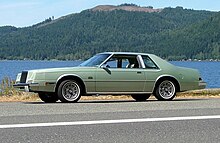
The Imperial marque was again resurrected for the model years 1981 through 1983 with a malaise era two-door coupe based on the second-generation Chrysler Cordoba platform with the designation Series YS.[44] All examples of the 1981–1983 Imperial used Chrysler's 318 cubic-inch V8 engine. All US built 1981 Imperials came standard with fuel injection, generating power of 104.5 kW (140 hp) and 0-60 mph in 13.4 seconds, with a top speed of 172 km/h (107 mph). Canadian built 1981 Imperials came with a 2 bbl carburetor. [45]
1990–1993
| Seventh generation | ||
|---|---|---|
Curb weight 3,519 lb (1,596 kg) | | |
| Chronology | ||
| Successor | Chrysler LHS | |


1990 saw a revival of the Imperial as a high-end sedan in Chrysler's lineup to replace the dated Fifth Avenue.
The reintroduction of the Imperial was two years after the
Though closely related, efforts were made to distinguish the Imperial from the New Yorker Fifth Avenue: the Imperial's nose was more wedge-shaped, while the New Yorker Fifth Avenue's initially had a sharper, more angular profile (before gaining a more rounded front and rear); the Imperial's rear was more contoured, the New Yorker Fifth Avenue's more sharply angled; the Imperial got a full-width taillight treatment (similar to the contemporary
Initially, the 1990 Imperial was powered by the 147 hp (110 kW) 3.3 L
This generation Imperial was a 6-passenger
All seventh-generation Imperials were covered by Chrysler's market-leading "Crystal Key Owner Care Program" which included a 5-year/50,000-mile limited warranty and a 7-year/70,000-mile powertrain warranty. A 24-hour toll-free customer service hotline was also provided.
As originally planned, this generation Chrysler Imperial was discontinued after the 1993 model year along with the Y-body and C-body New Yorkers. They were replaced by the new LH platform sedans. While the New Yorker name continued on for three more years, 1993 would be the last year for Imperial. The critically acclaimed cab-forward styled Chrysler LHS replaced the Imperial as Chrysler's flagship model for 1994.
Production figures and prices
| Year | Units | Original MSRP | 2020 Dollar Equivalent |
|---|---|---|---|
| 1990 | 14,968 | $25,655 | $59,831 |
| 1991 | 11,601 | $27,119 | $60,665 |
| 1992 | 7,643 | $28,453 | $61,777 |
| 1993 | 7,064 | $29,481 | $62,181 |
| Total | 41,276 | ||
2006
Concept car
| Chrysler Imperial Concept | |
|---|---|
Chrysler LY platform | |
| Related | Chrysler 300 |
| Dimensions | |
| Wheelbase | 123 in (3,124 mm) |
A Chrysler Imperial
On 17 July 2007, Chrysler officially announced it would drop the production plans for the Imperial. Citing increasing fuel costs and more stringent fuel economy standards expected from Capitol Hill, Chrysler said that the Imperial project was off, as a viable business case could no longer be made for the car. The Imperial had been rumored to be based on the future Mercedes R-Class or the next generation LX-platform (LY, or a combination of components) and it is suggested[by whom?] that all of the work done on the Imperial program will be rolled into the forthcoming LY-platform cars. These cars will include the next generation Chrysler 300/300C, the long-wheelbase 300/300C (perhaps renamed "New Yorker") with a much larger Imperial[clarification needed] similar in size, but not necessarily in style, to the Imperial Concept car of 2006.
-
Chrysler Imperial concept side view
-
Chrysler Imperial concept rear view
-
Doors open showing the interior
See also
References
- ^ ISBN 978-1-57958-367-5.
- ^ Hippensteele, Lee B. (May–June 1970). "Imperial: Dowager Queen of Chrysler Corporation". Antique Automobile: 14–23. Archived from the original on 2 March 2021. Retrieved 29 November 2010.
- ^ "1954 Pasadena Tournament of Roses Review (with 1954 Chrysler Imperial & Imperial Rose)". www.imperialclub.com. Archived from the original on 14 November 2019. Retrieved 18 April 2021.
- ^ a b "1926 Imperial Brochure". Oldcarbrochures.com. p. 17. Retrieved 14 March 2013.
- ^ ISBN 0-87341-478-0.
- ^ a b "1928 Factory Service Manual – License Data for the Chrysler Imperial "80"". Chrysler. 1928. Retrieved 10 August 2008. [dead link]
- ISBN 978-0-262-56055-9. Retrieved 11 March 2014.
- ^ Matthew Van Winkle, Aviation Gasoline Manufacture, McGraw-Hill, 1944, p. 10.
- ^ "1926 Imperial Brochure". Oldcarbrochures.com. p. 8. Retrieved 14 March 2013.
- ^ "1926 Imperial Brochure". Oldcarbrochures.com. p. 16. Retrieved 14 March 2013.
- ^ a b c d e f g h i j k l m n o p q r s t u v w x y z aa ab ac ad ae 1634–1699: McCusker, J. J. (1997). How Much Is That in Real Money? A Historical Price Index for Use as a Deflator of Money Values in the Economy of the United States: Addenda et Corrigenda (PDF). American Antiquarian Society. 1700–1799: McCusker, J. J. (1992). How Much Is That in Real Money? A Historical Price Index for Use as a Deflator of Money Values in the Economy of the United States (PDF). American Antiquarian Society. 1800–present: Federal Reserve Bank of Minneapolis. "Consumer Price Index (estimate) 1800–". Retrieved 29 February 2024.
- ^ a b c d e "1932 Chrysler Imperial Custom Eight Brochure". Oldcarbrochures.com. p. 13. Retrieved 14 March 2013.
- ^ a b "1931 Factory Service Manual". Chrysler. 1931. Retrieved 11 June 2008.[permanent dead link]
- ^ Wise, David Burgess (1974). "Cord: The Apex of a Triangle". In Northey, Tom (ed.). World of Automobiles: An Illustrated Encyclopedia of the Motor Car. Vol. 4. New York: Columbia House. pp. 435–437.
- ISBN 978-0-8143-3091-3. Retrieved 12 October 2012.
- ^ "1937 Chrysler Royal-Imperial Brochure". Oldcarbrochures.com. p. 39. Retrieved 14 March 2013.
- ^ "1934 Chrysler CW Brochure". Oldcarbrochures.com. p. 15. Retrieved 14 March 2013.
- ^ "1937 Chrysler Royal-Imperial Brochure". Oldcarbrochures.com. p. 39. Retrieved 14 March 2013.
- ^ "1937 Chrysler Royal-Imperial Brochure". Oldcarbrochures.com. p. 31. Retrieved 14 March 2013.
- ^ a b "1939 Chrysler Custom Imperial Brochure". Oldcarbrochures.com. p. 13. Retrieved 14 March 2013.
- ^ a b "1940 Chrysler Crown Imperial Brochure". Oldcarbrochures.com. p. 13. Retrieved 14 March 2013.
- ^ "1937 Chrysler Imperial CW Major Bowes". Hyman Ltd. Hyman Ltd. Retrieved 24 June 2021.
- ^ "Salazar's cars at Motorclássico Fair". Motorclassico.com. 30 April 2007. Archived from the original on 13 January 2014. Retrieved 11 March 2014.
- ^ "1948 Chrysler Imperial Crown Sedan Brochure". Oldcarbrochures.com. p. 4. Retrieved 14 March 2013.
- ^ ISBN 0-87341-027-0.
- ^ ISBN 978-0-7864-3229-5.
- ^ "1948 Chrysler Crown Imperial Limo Brochure". Oldcarbrochures.com. p. 4. Retrieved 14 March 2013.
- ^ ISBN 0-87341-521-3.
- ^ "1954 Imperial Brochure". Oldcarbrochures.com. pp. 17–18. Retrieved 14 March 2013.
- ^ "1951 Chrysler Imperial Brochure". Oldcarbrochures.com. p. 17. Retrieved 14 March 2013.
- ^ a b c "1951 Imperial vs Lincoln". Oldcarbrochures.com. p. 2. Retrieved 14 March 2013.
- ^ "1954 Imperial Brochure". Oldcarbrochures.com. p. 19. Retrieved 14 March 2013.
- ^ ISBN 0-87938-034-9.
- ISBN 978-0-7853-0778-5.
- ^ "Chrysler drops clutch pedal with new automatic transmission". Popular Mechanics. 100 (2): 81. August 1953.
- ^ "1953 Imperial Brochure". Oldcarbrochures.com. pp. 4–5. Retrieved 14 March 2013.
- ISBN 9781596130371. Retrieved 11 March 2014.
- ^ "Chrysler Promises Car Radio With Transistors Instead of Tubes in '56". The Wall Street Journal. 28 April 1955. p. 1.
- ^ Hirsh, Rick. "1955: Philco's All-Transistor Mopar Car Radio". Allpar.com. Retrieved 11 March 2014.
- ^ "Mopar 914-HR Ch= C-5690HR Car Radio Philco, Philadelphia". Radiomuseum.org. Retrieved 11 March 2014.
- ^ "Chrysler Heritage 1950–1959". Walter P. Chrysler Museum. Archived from the original on 2 January 2014. Retrieved 11 March 2014.
- ^ "Archived copy". Archived from the original on 16 January 2016. Retrieved 11 November 2015.
{{cite web}}: CS1 maint: archived copy as title (link) - ^ "1976 Chrysler New Yorker Brougham Home Page". www.imperialclub.com. Archived from the original on 2 March 2021. Retrieved 13 June 2019.
- ^ 1981 to 1983 Imperial cars: Cordoba based luxury, www.allpar.com. Retrieved 13 February 2018
- ^ "Detailed specs review of 1981 Chrysler Imperial 5.2L V-8 EFi TorqueFlite offered since October 1980 for North America U.S."
- ^ "1990–1993 Chrysler Imperial/New Yorker Fifth Avenue: Overview". auto.howstuffworks.com. Archived from the original on 20 September 2012. Retrieved 11 March 2014.
- ^ "1990 Chrylser [sic] Imperial Production Facts and Figures" Archived 14 November 2019 at the Wayback Machine. Retrieved 9 June 2010.






